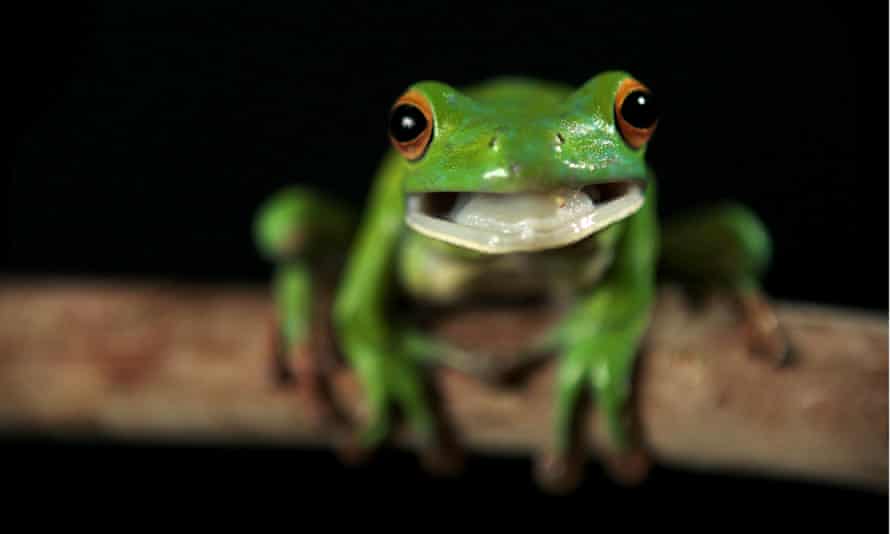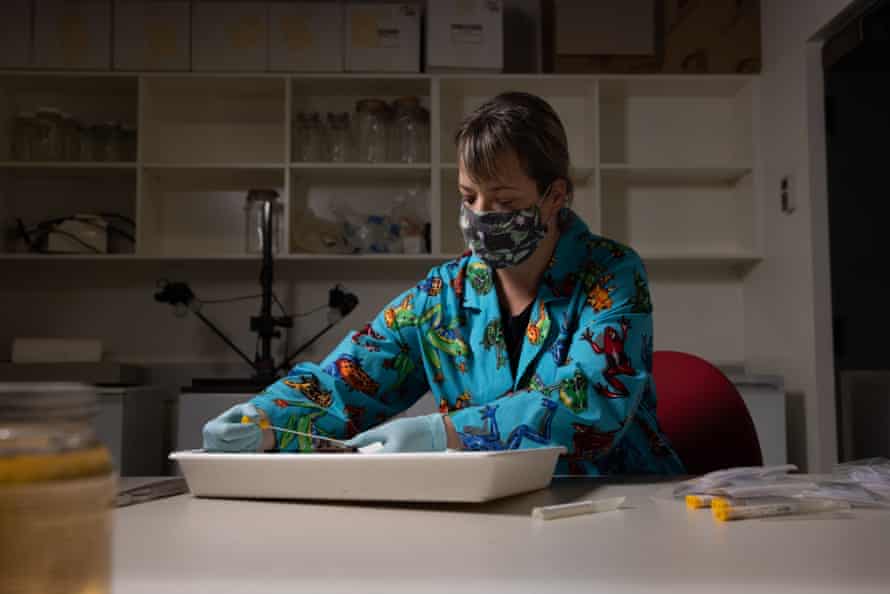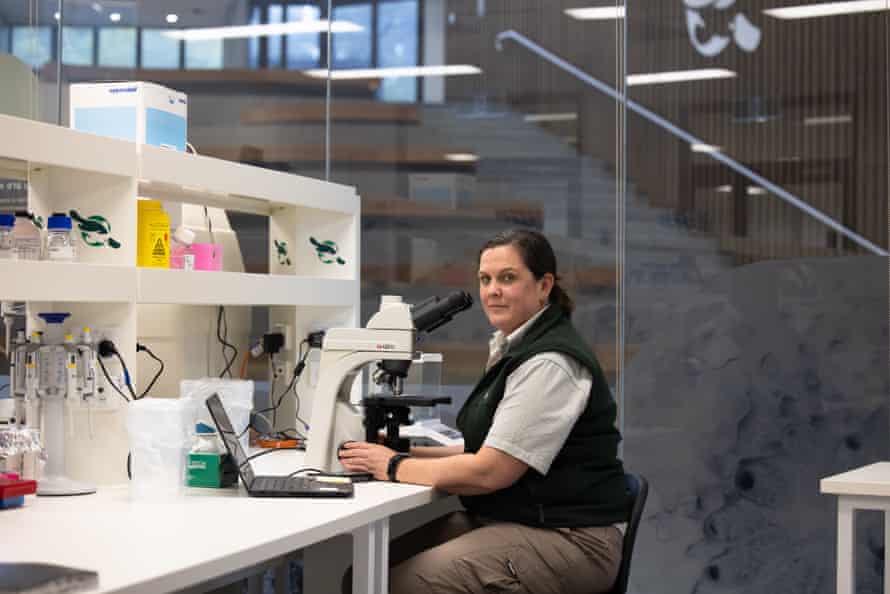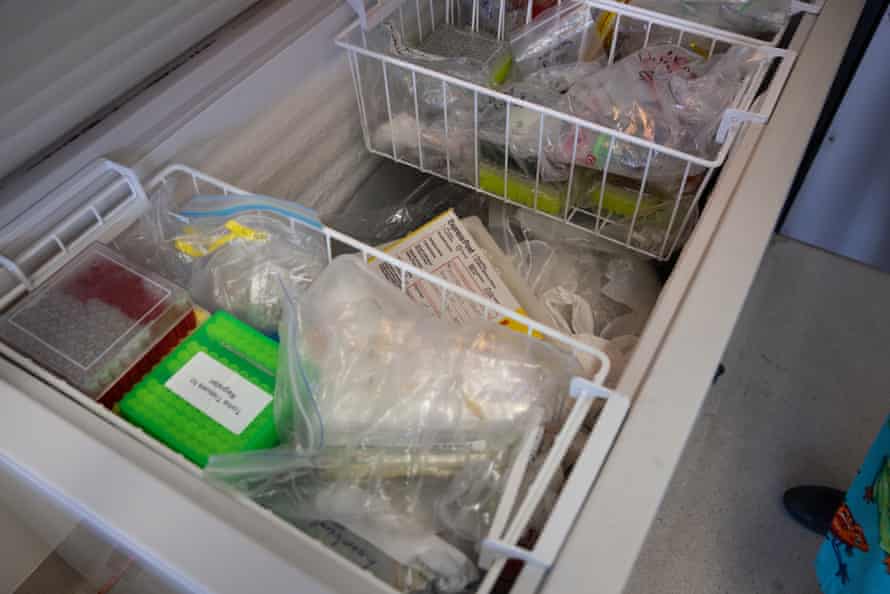Extract from The Guardian
After asking for public help with their investigations, scientists have received thousands of reports and specimens of dead, shrivelled frogs.

Last modified on Sun 19 Sep 2021 08.17 AEST
In the middle of Sydney’s lockdown, scientist Jodi Rowley has been retrieving frozen dead frogs from her doorstep.
Occasionally one will arrive dried and shrivelled up in the post.
She’ll pack them in ice in an esky to be taken to her lab at the Australian Museum, where even more samples – green tree frogs, striped marsh frogs and the invasive cane toad among them – are waiting in a freezer for genetic testing.
Rowley and her team, along with scientists at the Australian Registry of Wildlife Health at Taronga zoo and a forensic unit in the NSW department of planning, industry and environment, are trying to solve the mystery of what is killing Australia’s frogs.
Since late July, they’ve collected 1,200 records of dead or dying frogs, about 70% of them in New South Wales and 22% in Queensland.
“I know we’re dealing with our own pandemic but frogs are also dealing with a pandemic and whatever is going on right now is awful,” Rowley said.
“It’s like nothing in my lifetime that I’m aware of.”

One of the shrivelled frogs Australia Museum researcher Jodi Rowley has been sent. Photograph: Carly Earl/The Guardian
‘It’s really broken our hearts’
But its work shifted after Rowley did an ABC radio interview in late July to talk about dead green tree frogs that were being found around Scotts Head on the NSW mid north coast.
After that, Rowley started receiving emails about frogs in similar condition being found in other parts of the country.
A week later she and Karrie Rose, the head of Australian Registry of Wildlife Health, wrote a piece for the Conversation that asked people who spotted sick or dying amphibians to make a report through the FrogID email.
They received 160 emails in 24 hours. That’s grown to more than 2,000 since.
“It’s been quite devastating to be at the receiving end of some of these emails. I can only imagine how hard it is for the people out there who are seeing these frogs.”

Rowley at work in her lab. Photograph: Carly Earl/The Guardian
One of those reports came from Yvonne Hulbert, who runs a bed and breakfast on an acreage on Macleay Island near Brisbane, where there is a thriving frog population.
Over the past few months they’ve found browning and dead frogs along their properties.
“They go a fawny beige colour then turn brown. They seem to get dry and they become emaciated and then shrivel and become skeletons,” Hulbert said.
“We recognise the same frogs and they just decline in health and size and eventually their eyes dull and they just die. It’s really sad.”
“We keep what we call the frog-cuzzi, a little pool for them to swim in, and we love having them here because they kill spiders and pests.”
But in recent months, Wilson-Lutter noticed frogs were leaving loose skin in their little pool and others were changing colour or turning up dead.
“It’s really broken our hearts, because we love our frogs,” Wilson-Lutter says.
Too early to draw conclusions
Over the past two-and-a-half months, the scientists have collected reports of 31 different species affected in almost every state and territory.
Of those, 30 species are native – including endangered frogs such as green and golden bell frogs, southern bell frogs and the giant barred frog. The one invasive species is the cane toad.
Sixty per cent of the frogs found are green tree frogs, something likely explained by the fact they are a common species found in and around people’s homes.
The frogs that are found alive are often lethargic and emaciated, with red bellies and coloured patches on their skin.
When frogs die, they shrivel up quickly, so many have been found dark brown and withered.

Jane Hall at the Australian Registry of Wildlife Health at Taronga zoo. Photograph: Carly Earl/The Guardian
The two scientists have been conducting necropsies on frog carcasses at a pathology facility at Taronga zoo that acts as a morgue and a lab.
They dissect the frogs, looking for any indicators of disease, and take samples from their liver, kidneys, blood and stomach content if they have any.
Over at the Australian Museum, Rowley and her team are looking at the animals on a molecular level.
Much like a Covid-19 test, they swab the frogs – usually on their belly and legs – and also take a small skin sample. They then run DNA tests looking for pathogens that might indicate a virus or a fungus.
At present, the number one candidate for what has caused the mass mortality event is chytrid fungus, which has been responsible for declines of more than 500 amphibian species globally.
It is more likely to take hold during winter months, when frogs’ immune systems slow down.
Some of the tests have returned a positive result, but Rowley and Hall both say it is too early to draw conclusions.
Covid-19 lockdowns have also hampered the ability to do investigations in the field.

The freezer containing some of the samples Jodi Rowley has been sent. Photograph: Carly Earl/The Guardian
Others will conduct a basic necropsy and keep the rest of the carcass in a fixative to be examined microscopically later on.
Friends and family members are also storing frozen frogs that have been dropped in mailboxes by people from their communities.
Separately, a forensic team is running toxicology tests looking for things like pesticides, heavy metals or other environmental toxins.
There has been widespread pesticide use as a result of the recent mouse plague. Hall says it is unlikely to be the cause, but it needs to be ruled out.
When the lockdowns end, the scientists will have more access to more samples and locations to expand their work, do targeted surveys, and build a larger syndromic picture to work out what the common threads are.
If it is chytrid fungus, Rowley says it would be the largest such mortality event in Australia in more than a decade.
“The question then becomes why would it be impacting so much more now?” she says.
“Whether it’s to do with climate, the very cold winter, or it’s interacting with another stressor such as not enough food or pollution. It could be a new strain or something from overseas.”
Hall says there is no better example of how a pathogen can change than the current pandemic.
“Pathogens are always looking for ways they can improve how they work and move in animals,” she says.
“Chytrid can change, so we want to see if it’s the chytrid our frogs are used to being exposed to or if it’s a different kind of chytrid.”
She says another important and still to be answered question is whether the animals are dying of or with the disease – that is, if it is just a contributing factor and other environmental stressors of recent years such as droughts, fires and climate change have played a role. Alternatively, the cause could be something else entirely, like a novel pathogen.
“Once we get more of an understanding of these things we can go to the next level and see how far it’s spread and what long-term effect it might have on vulnerable amphibian populations across Australia,” she says.
“They’re probably the best indicator of environmental health. It’s important we don’t ignore them.
“They absorb the environment through their skin so if something is off … the frogs will let us know.”
Anyone who spots an unwell or dead frog is encouraged to contact the FrogID project email on calls@frogid.net.au with the location and photos if possible.
No comments:
Post a Comment